NDVI stands for "Normalized Difference Vegetation Index". NRG stands for "Near-infrared / Red / Green". NDVI and NRG are both ways to visualize the amounts of infrared and other wavelengths of light reflected from vegetation. Because both these methods compare ratios of blue and red light absorbed versus green and IR light reflected, they can be used to evaluate the health of vegetation. It's a snapshot of how much photosynthesis is happening. This is helpful in assessing vegetative health or stress. (Read more here: https://www.agronomy.org/publications/jeq/articles/36/3/832) ## Do-It-Yourself These techniques for vegetation analysis were developed for satellite imagery, but at Public Lab, we've been working a lot on capturing infrared imagery using our DIY [near-infrared camera](/wiki/near-infrared-camera) setup, and combining it with visible bands to produce NDVI images such as the one above. ## What these images mean What exactly are these images we're trying to make? What do they tell us about vegetation, and why? These diagrams should help to understand what it is we're doing and why these are good ways to analyze plant life. ## The NDVI equation [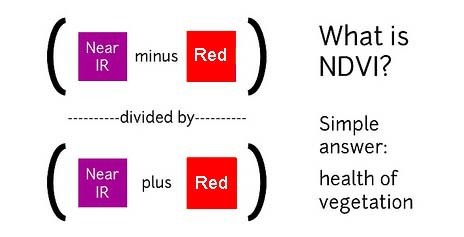](/i/44723) **NDVI = (Near Infrared - Red)/(Near Infrared + Red)** NDVI is a ratio which tries to emphasize photosynthesis while filtering out sun glare. The above equation is run for every pixel, using source data from an infrared photo and a visible light photo, like this pair: [](https://publiclab.org/system/images/photos/000/021/771/original/5390895115_c9d4d38fec_o.jpg) The result can be false-colored to make the high-photosynthesis areas more clear, and used to examine where plants are and how healthy they are. [](https://publiclab.org/system/images/photos/000/021/770/original/PetVISNDVIcomp.png) _Figure above: Normal color photo (right) and normalized difference vegetation index (NDVI) image (left). NDVI image was derived from two color channels in a single photo taken with a camera modified with a special infrared filter. Note that tree trunks, brown grass, and rocks have very low NDVI values because they are not photosynthetic. Healthy plants typically have NDVI values between 0.1 and 0.9. -- @cfastie_ ### Activities Here are a range of activities you can do to produce and interpret your own NDVI imagery, whether downloaded from a satellite imagery provider or [collected yourself using a DIY technique](/wiki/multispectral-imaging) [activities:ndvi] ****   Most DIY converted cameras today (those from Public Lab) use RGN instead of NRG, so the blue channel represents infrared instead of the red channel. That looks like this: [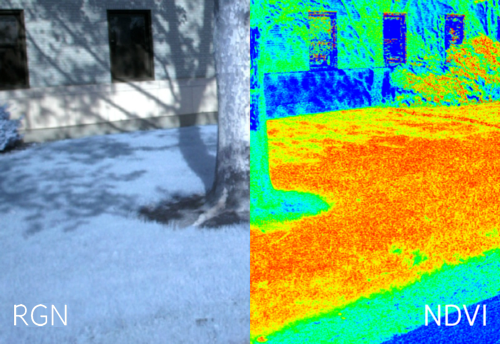](/i/45468?s=o) **** ## NRG imagery Some people are also interested in producing NRG imagery (like the below image), where `Near-Infrared, Red, and Green` are used to compose a picture instead of the usual `Red, Green, and Blue`. [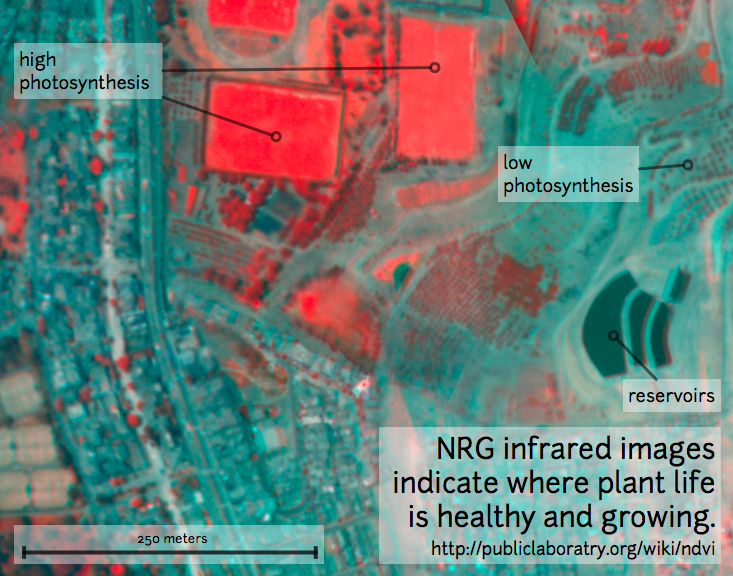](/i/25064) This diagram explains the swapping, which allows us to 'see' infrared as if it were a normal color: [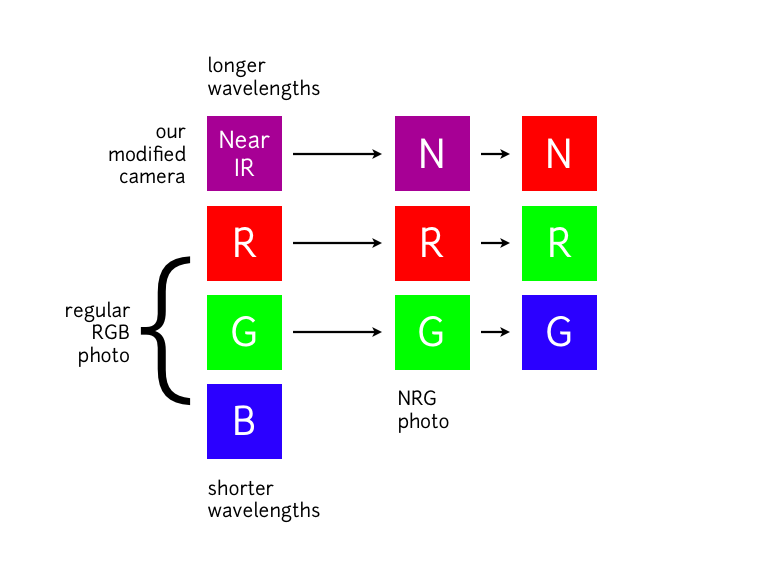](/i/25063) **In NRG images, the deeper and clearer the red color, the denser and healthier the vegetation (more or less).** ### Questions [questions:ndvi] ### Other examples of DIY NDVI imaging From around the internet: Begin watching at 2 minutes to see the resulting imagery: *This topic is part of the [Grassroots Mapping Curriculum](/wiki/mapping-curriculum) series.* **** [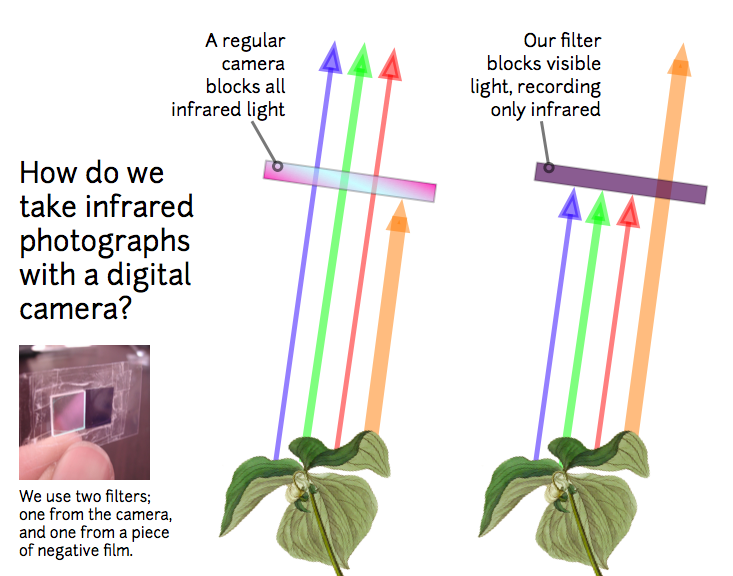](/i/25066) [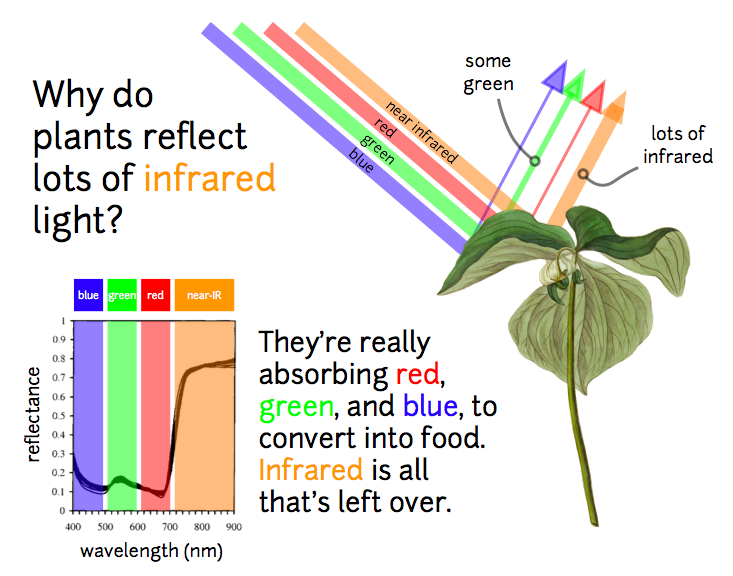](/i/25065) ...
| Author | Comment | Last activity | Moderation | ||
|---|---|---|---|---|---|
| warren | " Great to hear from you @maggpi! This is tremendous! " | Read more » | almost 6 years ago | |||
| warren | "@warren awards a barnstar to MaggPi for their awesome contribution! " | Read more » | almost 6 years ago | |||
| cagiva | "@cfastie, You were absolutely correct. The Blue card from PublicLab arrived today so I redid the white-balancing calibration with it and I got much..." | Read more » | almost 6 years ago | |||
| cagiva | "Hi @Tbtouaki Was your NDVI balloon mapping a research project? Were you able to publish the results in a paper or blog? Best, ~~Al " | Read more » | almost 6 years ago | |||
| cfastie | "Performing a custom white balance on a blue-filtered NIR camera fools the camera into exaggerating the brightness of the red channel. The red chann..." | Read more » | almost 6 years ago | |||
| cfastie | "It will always be difficult to know for sure to what degree the red channel is contaminated by NIR. It might be worthwhile making an estimate. For ..." | Read more » | almost 6 years ago | |||
| Anice | "Thank you for your immediate response Chris. This is very helpful! Regarding modifying the values in the red channel of the aerial photos, I have ..." | Read more » | almost 6 years ago | |||
| cfastie | "Although the absolute values you computed for NDVI are lower than they should be, it appears that your process is successfully discriminating betwe..." | Read more » | almost 6 years ago | |||
| Anice | " Thank you so much Chris! This information is very helpful. I plan on researching about the spectral sensitivity of my camera (Canon SX230 HS) and ..." | Read more » | about 6 years ago | |||
| cfastie | "You are correct that both red and NIR pass through the red filter (Rosco Fire # 19) and both are captured in the red channel of the photograph. It ..." | Read more » | about 6 years ago | |||
| Tasos | " Hey jtuhtan ! I'm trying to create a colormap like yours in matlab, but cannot figure it out how to change half of the color range (from -1 to 0)..." | Read more » | about 6 years ago | |||
| CD3000 | "Very beautiful observation! My hypothesis is that chloroplast density is less in new vegetation, but also reflectance/absorbance/transmittance is ..." | Read more » | about 6 years ago | |||
| nedhorning | "It's worth testing but those cards you link to look promising. From my experience it's the bright target that is more of a problem than the dark ta..." | Read more » | about 6 years ago | |||
| warren | "ah, good point. I guess both are relevant. We could distribute them in a dark envelope or folder, perhaps. Yes, i also wondered about this -- bot..." | Read more » | about 6 years ago | |||
| nedhorning | "Hi Jeff - I wasn't sure if you mean varying over time or over the surface. Over time both will vary but from my experience they seem fairly stable ..." | Read more » | about 6 years ago | |||
| warren | "Hi, @nedhorning! I wanted to ask if you thought tar paper that people purchase in a store would have a consistent enough reflectance that you think..." | Read more » | about 6 years ago | |||
| maykef | " " | Read more » | about 6 years ago | |||
| maykef | "Some new pictures taken with the Multispectral camera: " | Read more » | about 6 years ago | |||
| maykef | "Sure. " | Read more » | about 6 years ago | |||
| warren | "Wow, very cool. Could you post a pic of the dual cameras too? " | Read more » | about 6 years ago | |||
| maykef | "Here is the picture for better appreciation: " | Read more » | about 6 years ago | |||
| maykef | "Registration is done in Matlab as per this tutorial: https://uk.mathworks.com/help/vision/examples/find-image-rotation-and-scale-using-automated-fe..." | Read more » | about 6 years ago | |||
| maykef | "Is this the correct order of the filters? " | Read more » | about 6 years ago | |||
| warren | "Ah, but perhaps you're using the wrong filter setting in Image Sequencer -- it looks like potentially the NDVI values are inverse? " | Read more » | about 6 years ago |